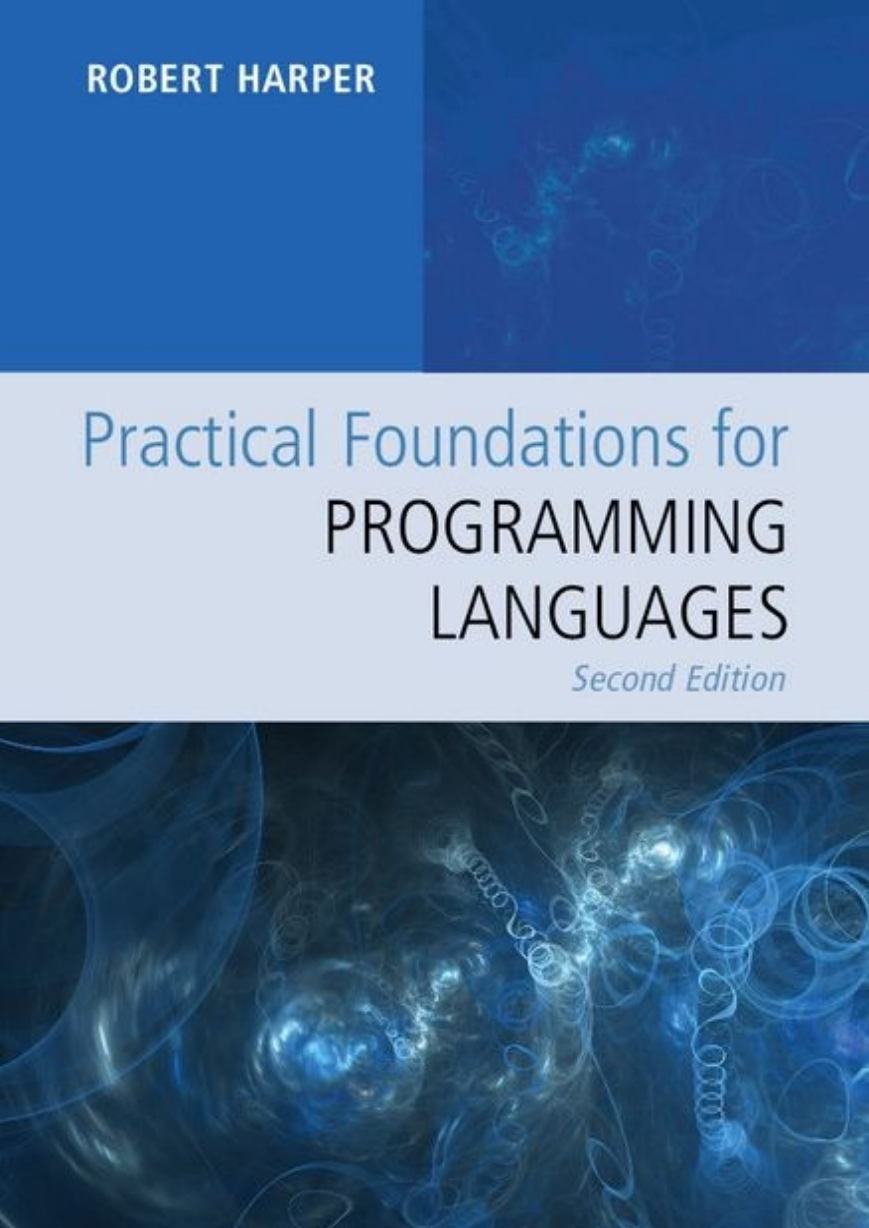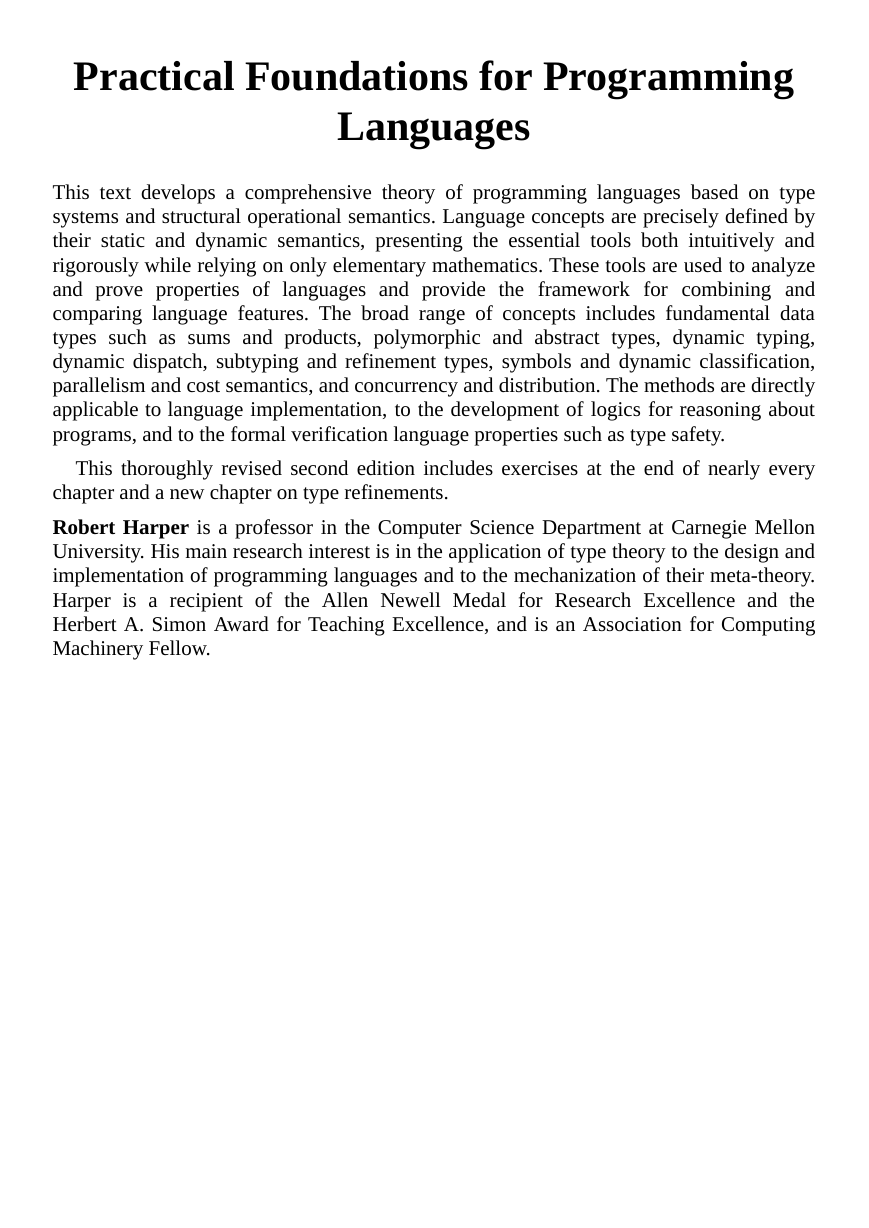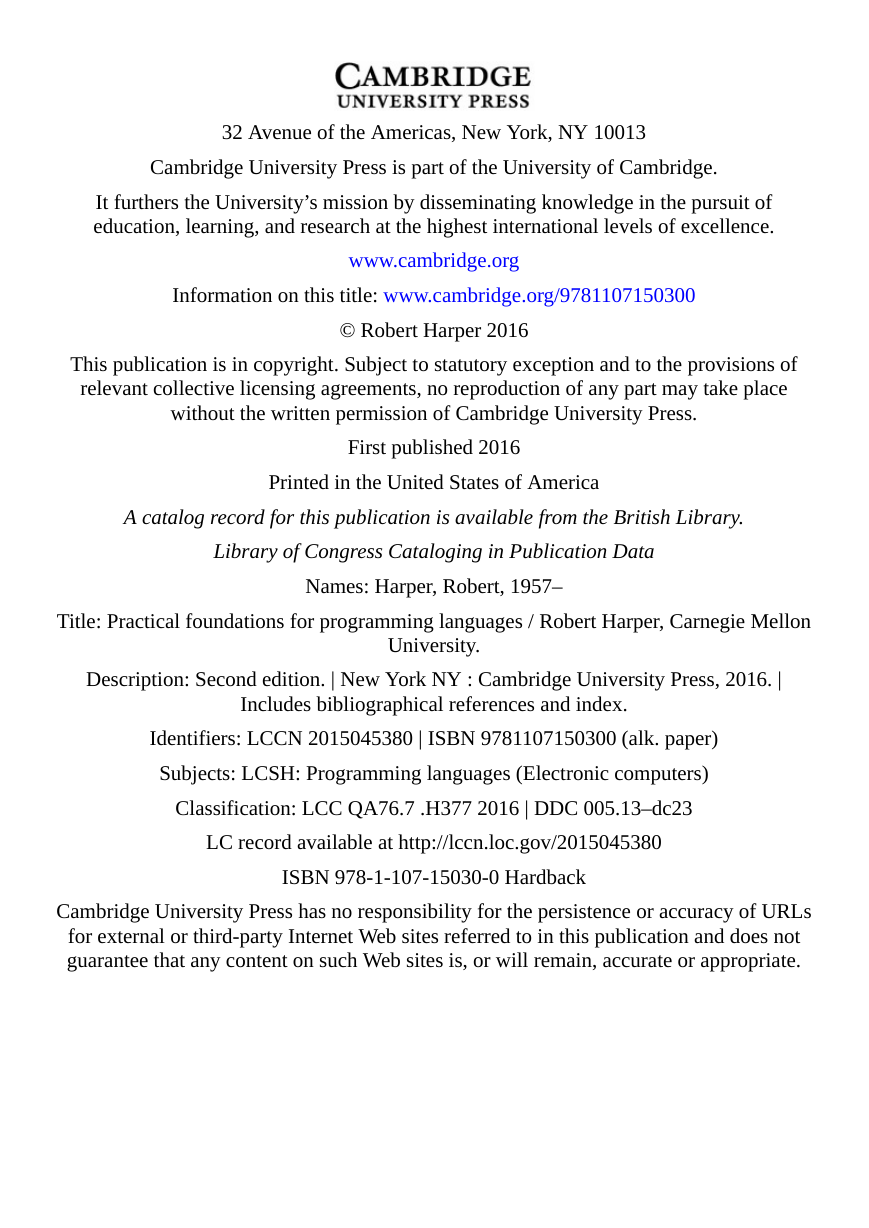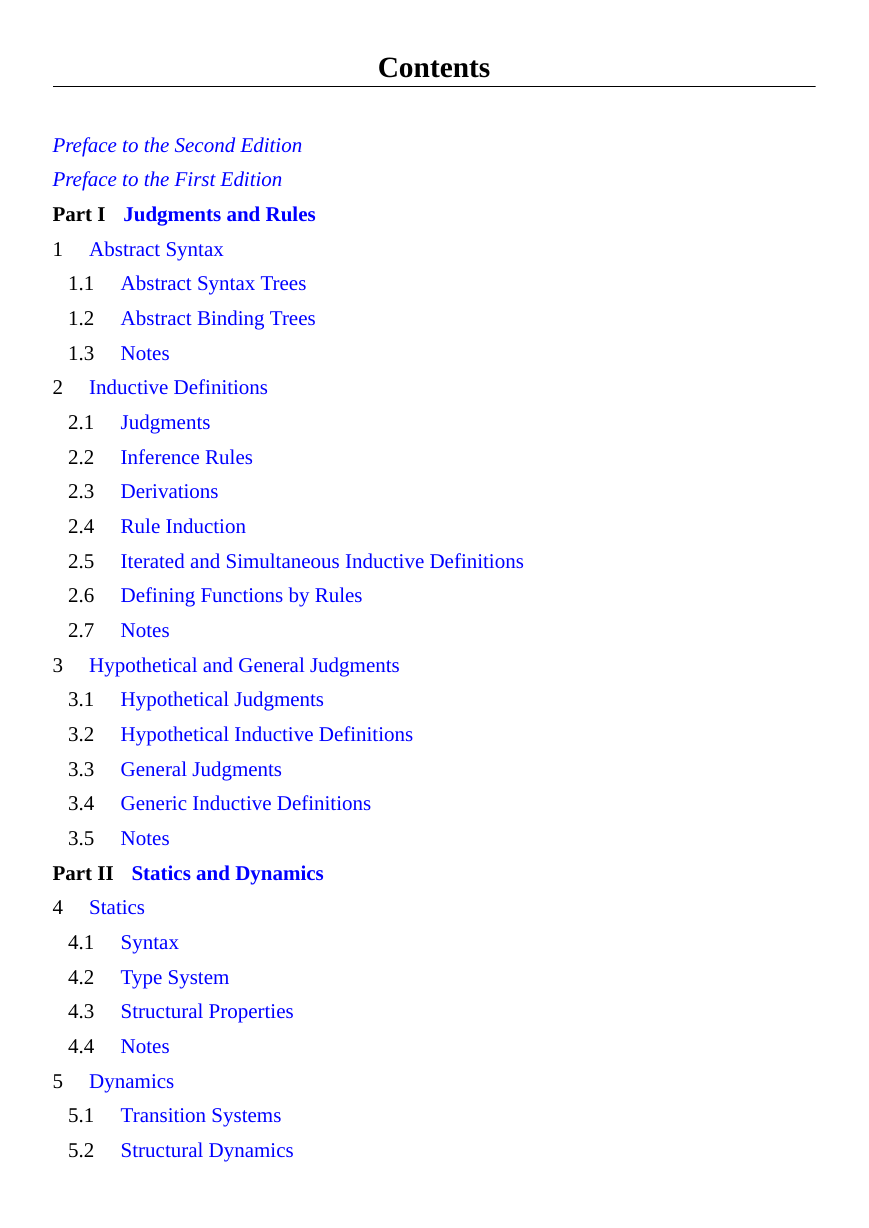Half title
Title
Copyright
Table of Contents
Preface to the Second Edition
Preface to the First Edition
Part I Judgments and Rules
1 Abstract Syntax
1.1 Abstract Syntax Trees
1.2 Abstract Binding Trees
1.3 Notes
2 Inductive Definitions
2.1 Judgments
2.2 Inference Rules
2.3 Derivations
2.4 Rule Induction
2.5 Iterated and Simultaneous Inductive Definitions
2.6 Defining Functions by Rules
2.7 Notes
3 Hypothetical and General Judgments
3.1 Hypothetical Judgments
3.2 Hypothetical Inductive Definitions
3.3 General Judgments
3.4 Generic Inductive Definitions
3.5 Notes
Part II Statics and Dynamics
4 Statics
4.1 Syntax
4.2 Type System
4.3 Structural Properties
4.4 Notes
5 Dynamics
5.1 Transition Systems
5.2 Structural Dynamics
5.3 Contextual Dynamics
5.4 Equational Dynamics
5.5 Notes
6 Type Safety
6.1 Preservation
6.2 Progress
6.3 Run-Time Errors
6.4 Notes
7 Evaluation Dynamics
7.1 Evaluation Dynamics
7.2 Relating Structural and Evaluation Dynamics
7.3 Type Safety, Revisited
7.4 Cost Dynamics
7.5 Notes
Part III Total Functions
8 Function Definitions and Values
8.1 First-Order Functions
8.2 Higher-Order Functions
8.3 Evaluation Dynamics and Definitional Equality
8.4 Dynamic Scope
8.5 Notes
9 System T of Higher-Order Recursion
9.1 Statics
9.2 Dynamics
9.3 Definability
9.4 Undefinability
9.5 Notes
Part IV Finite Data Types
10 Product Types
10.1 Nullary and Binary Products
10.2 Finite Products
10.3 Primitive Mutual Recursion
10.4 Notes
11 Sum Types
11.1 Nullary and Binary Sums
11.2 Finite Sums
11.3 Applications of Sum Types
11.4 Notes
Part V Types and Propositions
12 Constructive Logic
12.1 Constructive Semantics
12.2 Constructive Logic
12.3 Proof Dynamics
12.4 Propositions as Types
12.5 Notes
13 Classical Logic
13.1 Classical Logic
13.2 Deriving Elimination Forms
13.3 Proof Dynamics
13.4 Law of the Excluded Middle
13.5 The Double-Negation Translation
13.6 Notes
Part VI Infinite Data Types
14 Generic Programming
14.1 Introduction
14.2 Polynomial Type Operators
14.3 Positive Type Operators
14.4 Notes
15 Inductive and Coinductive Types
15.1 Motivating Examples
15.2 Statics
15.3 Dynamics
15.4 Solving Type Equations
15.5 Notes
Part VII Variable Types
16 System F of Polymorphic Types
16.1 Polymorphic Abstraction
16.2 Polymorphic Definability
16.3 Parametricity Overview
16.4 Notes
17 Abstract Types
17.1 Existential Types
17.2 Data Abstraction
17.3 Definability of Existential Types
17.4 Representation Independence
17.5 Notes
18 Higher Kinds
18.1 Constructors and Kinds
18.2 Constructor Equality
18.3 Expressions and Types
18.4 Notes
Part VIII Partiality and Recursive Types
19 System PCF of Recursive Functions
19.1 Statics
19.2 Dynamics
19.3 Definability
19.4 Finite and Infinite Data Structures
19.5 Totality and Partiality
19.6 Notes
20 System FPC of Recursive Types
20.1 Solving Type Equations
20.2 Inductive and Coinductive Types
20.3 Self-Reference
20.4 The Origin of State
20.5 Notes
Part IX Dynamic Types
21 The Untyped λ-Calculus
21.1 The λ-Calculus
21.2 Definability
21.3 Scott’s Theorem
21.4 Untyped Means Uni-Typed
21.5 Notes
22 Dynamic Typing
22.1 Dynamically Typed PCF
22.2 Variations and Extensions
22.3 Critique of Dynamic Typing
22.4 Notes
23 Hybrid Typing
23.1 A Hybrid Language
23.2 Dynamic as Static Typing
23.3 Optimization of Dynamic Typing
23.4 Static versus Dynamic Typing
23.5 Notes
Part X Subtyping
24 Structural Subtyping
24.1 Subsumption
24.2 Varieties of Subtyping
24.3 Variance
24.4 Dynamics and Safety
24.5 Notes
25 Behavioral Typing
25.1 Statics
25.2 Boolean Blindness
25.3 Refinement Safety
25.4 Notes
Part XI Dynamic Dispatch
26 Classes and Methods
26.1 The Dispatch Matrix
26.2 Class-Based Organization
26.3 Method-Based Organization
26.4 Self-Reference
26.5 Notes
27 Inheritance
27.1 Class and Method Extension
27.2 Class-Based Inheritance
27.3 Method-Based Inheritance
27.4 Notes
Part XII Control Flow
28 Control Stacks
28.1 Machine Definition
28.2 Safety
28.3 Correctness of the K Machine
28.4 Notes
29 Exceptions
29.1 Failures
29.2 Exceptions
29.3 Exception Values
29.4 Notes
30 Continuations
30.1 Overview
30.2 Continuation Dynamics
30.3 Coroutines from Continuations
30.4 Notes
Part XIII Symbolic Data
31 Symbols
31.1 Symbol Declaration
31.2 Symbol References
31.3 Notes
32 Fluid Binding
32.1 Statics
32.2 Dynamics
32.3 Type Safety
32.4 Some Subtleties
32.5 Fluid References
32.6 Notes
33 Dynamic Classification
33.1 Dynamic Classes
33.2 Class References
33.3 Definability of Dynamic Classes
33.4 Applications of Dynamic Classification
33.5 Notes
Part XIV Mutable State
34 Modernized Algol
34.1 Basic Commands
34.2 Some Programming Idioms
34.3 Typed Commands and Typed Assignables
34.4 Notes
35 Assignable References
35.1 Capabilities
35.2 Scoped Assignables
35.3 Free Assignables
35.4 Safety
35.5 Benign Effects
35.6 Notes
36 Lazy Evaluation
36.1 PCF By-Need
36.2 Safety of PCF By-Need
36.3 FPC By-Need
36.4 Suspension Types
36.5 Notes
Part XV Parallelism
37 Nested Parallelism
37.1 Binary Fork-Join
37.2 Cost Dynamics
37.3 Multiple Fork-Join
37.4 Bounded Implementations
37.5 Scheduling
37.6 Notes
38 Futures and Speculations
38.1 Futures
38.2 Speculations
38.3 Parallel Dynamics
38.4 Pipelining with Futures
38.5 Notes
Part XVI Concurrency and Distribution
39 Process Calculus
39.1 Actions and Events
39.2 Interaction
39.3 Replication
39.4 Allocating Channels
39.5 Communication
39.6 Channel Passing
39.7 Universality
39.8 Notes
40 Concurrent Algol
40.1 Concurrent Algol
40.2 Broadcast Communication
40.3 Selective Communication
40.4 Free Assignables as Processes
40.5 Notes
41 Distributed Algol
41.1 Statics
41.2 Dynamics
41.3 Safety
41.4 Notes
Part XVII Modularity
42 Modularity and Linking
42.1 Simple Units and Linking
42.2 Initialization and Effects
42.3 Notes
43 Singleton Kinds and Subkinding
43.1 Overview
43.2 Singletons
43.3 Dependent Kinds
43.4 Higher Singletons
43.5 Notes
44 Type Abstractions and Type Classes
44.1 Type Abstraction
44.2 Type Classes
44.3 A Module Language
44.4 First- and Second-Class
44.5 Notes
45 Hierarchy and Parameterization
45.1 Hierarchy
45.2 Abstraction
45.3 Hierarchy and Abstraction
45.4 Applicative Functors
45.5 Notes
Part XVIII Equational Reasoning
46 Equality for System T
46.1 Observational Equivalence
46.2 Logical Equivalence
46.3 Logical and Observational Equivalence Coincide
46.4 Some Laws of Equality
46.5 Notes
47 Equality for System PCF
47.1 Observational Equivalence
47.2 Logical Equivalence
47.3 Logical and Observational Equivalence Coincide
47.4 Compactness
47.5 Lazy Natural Numbers
47.6 Notes
48 Parametricity
48.1 Overview
48.2 Observational Equivalence
48.3 Logical Equivalence
48.4 Parametricity Properties
48.5 Representation Independence, Revisited
48.6 Notes
49 Process Equivalence
49.1 Process Calculus
49.2 Strong Equivalence
49.3 Weak Equivalence
49.4 Notes
Part XIX Appendices
A Background on Finite Sets
Bibliography
Index
















 2023年江西萍乡中考道德与法治真题及答案.doc
2023年江西萍乡中考道德与法治真题及答案.doc 2012年重庆南川中考生物真题及答案.doc
2012年重庆南川中考生物真题及答案.doc 2013年江西师范大学地理学综合及文艺理论基础考研真题.doc
2013年江西师范大学地理学综合及文艺理论基础考研真题.doc 2020年四川甘孜小升初语文真题及答案I卷.doc
2020年四川甘孜小升初语文真题及答案I卷.doc 2020年注册岩土工程师专业基础考试真题及答案.doc
2020年注册岩土工程师专业基础考试真题及答案.doc 2023-2024学年福建省厦门市九年级上学期数学月考试题及答案.doc
2023-2024学年福建省厦门市九年级上学期数学月考试题及答案.doc 2021-2022学年辽宁省沈阳市大东区九年级上学期语文期末试题及答案.doc
2021-2022学年辽宁省沈阳市大东区九年级上学期语文期末试题及答案.doc 2022-2023学年北京东城区初三第一学期物理期末试卷及答案.doc
2022-2023学年北京东城区初三第一学期物理期末试卷及答案.doc 2018上半年江西教师资格初中地理学科知识与教学能力真题及答案.doc
2018上半年江西教师资格初中地理学科知识与教学能力真题及答案.doc 2012年河北国家公务员申论考试真题及答案-省级.doc
2012年河北国家公务员申论考试真题及答案-省级.doc 2020-2021学年江苏省扬州市江都区邵樊片九年级上学期数学第一次质量检测试题及答案.doc
2020-2021学年江苏省扬州市江都区邵樊片九年级上学期数学第一次质量检测试题及答案.doc 2022下半年黑龙江教师资格证中学综合素质真题及答案.doc
2022下半年黑龙江教师资格证中学综合素质真题及答案.doc